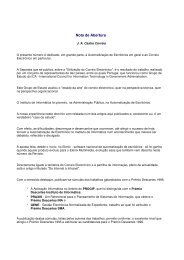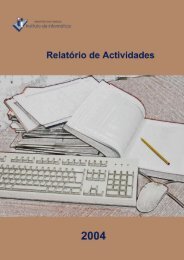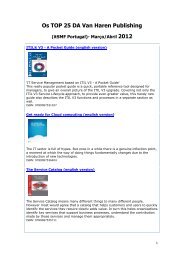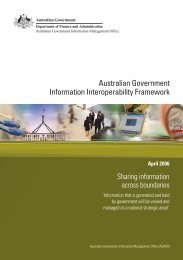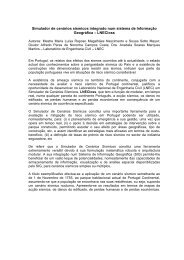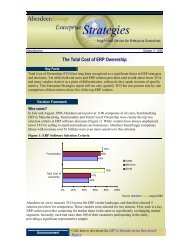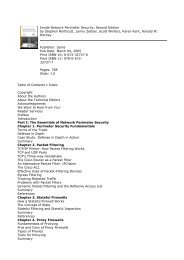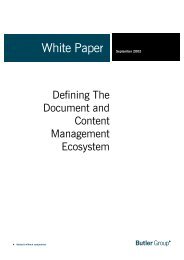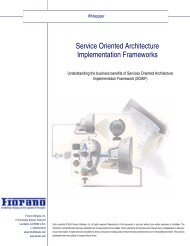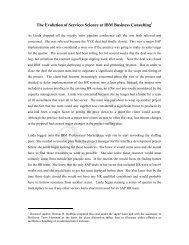OECD Peer Review of E-Government in Denmark - ePractice.eu
OECD Peer Review of E-Government in Denmark - ePractice.eu
OECD Peer Review of E-Government in Denmark - ePractice.eu
You also want an ePaper? Increase the reach of your titles
YUMPU automatically turns print PDFs into web optimized ePapers that Google loves.
number <strong>of</strong> organisations are see<strong>in</strong>g and seiz<strong>in</strong>g the opportunity to use ICT to automate or redef<strong>in</strong>e<br />
their bus<strong>in</strong>ess processes, with the goal <strong>of</strong> deliver<strong>in</strong>g improved services and/or improv<strong>in</strong>g the efficiency<br />
<strong>of</strong> their operations. The M<strong>in</strong>istry <strong>of</strong> Foreign Affairs exemplifies this type <strong>of</strong> e-government impact. It<br />
has used ICT to support real-time operations, and is us<strong>in</strong>g the Internet to change the way its bus<strong>in</strong>ess is<br />
conducted. Accord<strong>in</strong>g to an <strong>in</strong>terview with M<strong>in</strong>istry <strong>of</strong>ficials, e-government is used to “give diplomats<br />
an edge by provid<strong>in</strong>g them with the <strong>in</strong>formation they require as quickly as possible, so that they can do<br />
their job better”.<br />
One area where e-government has had a significant impact on organisational change is the<br />
improvement <strong>of</strong> back-<strong>of</strong>fice processes, especially at the all-<strong>of</strong>-government level. For example,<br />
electronic <strong>in</strong>voic<strong>in</strong>g <strong>of</strong> services provided to government, based on the OIOXML standard, has been<br />
mandatory s<strong>in</strong>ce February 2005. The use <strong>of</strong> the new eFaktura <strong>in</strong>voic<strong>in</strong>g system has had a positive<br />
impact <strong>in</strong> terms <strong>of</strong> generat<strong>in</strong>g sav<strong>in</strong>gs for both government and bus<strong>in</strong>esses (see Chapter 6 for further<br />
<strong>in</strong>formation). As another example, an electronic data management system, the FESD electronic<br />
document management project, has been <strong>in</strong>strumental <strong>in</strong> achiev<strong>in</strong>g greater efficiency and more<br />
effective project management by chang<strong>in</strong>g work processes and strengthen<strong>in</strong>g <strong>in</strong>ternal capacities (see<br />
Chapter 6).<br />
However, the use <strong>of</strong> ICT to improve the efficiency <strong>of</strong> bus<strong>in</strong>ess processes has a cost. The pressure<br />
<strong>of</strong> day-to-day bus<strong>in</strong>ess and the existence <strong>of</strong> different organisational functions, and compet<strong>in</strong>g priorities<br />
and workloads, can make it seem less convenient or desirable to <strong>in</strong>vest new resources <strong>in</strong> ICT and<br />
e-government <strong>in</strong> order to improve cross-agency processes. Some commentators, while recognis<strong>in</strong>g the<br />
importance <strong>of</strong> the work be<strong>in</strong>g led by the Task Force <strong>in</strong> this area (for example, <strong>in</strong> promot<strong>in</strong>g the<br />
<strong>in</strong>troduction <strong>of</strong> FESD), po<strong>in</strong>ted out that it can be very difficult to achieve such objectives.<br />
Organisations face <strong>in</strong>ternal competition for the resources required to participate <strong>in</strong> such <strong>in</strong>itiatives, and<br />
must cont<strong>in</strong>ue to meet quality and quantity standards for delivery <strong>of</strong> both <strong>in</strong>ternal and external<br />
processes and services while potentially mak<strong>in</strong>g changes to those processes. Importantly, these<br />
resources are both f<strong>in</strong>ancial and non-f<strong>in</strong>ancial (e.g. project management skills, specialist e-government<br />
skills, experience <strong>in</strong> <strong>in</strong>tegrat<strong>in</strong>g ICT, and an understand<strong>in</strong>g <strong>of</strong> the bus<strong>in</strong>ess <strong>of</strong> organisations). Such<br />
skills, which are costly, are also <strong>in</strong> relatively short supply <strong>in</strong> <strong>Denmark</strong>.<br />
Impact on organisational values and culture<br />
The use <strong>of</strong> ICT <strong>in</strong> government can also have an impact on organisational values and culture,<br />
help<strong>in</strong>g br<strong>in</strong>g about new ideas and work<strong>in</strong>g models based on pr<strong>in</strong>ciples such as achiev<strong>in</strong>g greater<br />
flexibility <strong>in</strong> work<strong>in</strong>g arrangements, and <strong>in</strong>creas<strong>in</strong>g openness and transparency <strong>in</strong> government. In<br />
<strong>Denmark</strong> a majority (62%) <strong>of</strong> respondents to the <strong>OECD</strong> survey <strong>in</strong>dicated that e-government has had a<br />
positive impact on transparency.<br />
Despite this, efforts to <strong>in</strong>crease the use <strong>of</strong> ICT as a tool for effective communication with and<br />
with<strong>in</strong> government have not brought about radical change <strong>in</strong> the way users deal with government.<br />
Projects and <strong>in</strong>itiatives led by the Digital Task Force (especially eDay) have aimed to promote a<br />
culture <strong>of</strong> paperless communication across government. However, while progress has been made,<br />
users demonstrate some resistance to chang<strong>in</strong>g their habits when deal<strong>in</strong>g with government. As shown<br />
<strong>in</strong> Figure 5.2 below, while an <strong>in</strong>creas<strong>in</strong>g number <strong>of</strong> organisations exchange at least 25% <strong>of</strong> documents<br />
electronically, the large majority <strong>of</strong> government organisations still exchange less than 25% <strong>of</strong><br />
documents <strong>in</strong> this manner. It is notable that the lowest level <strong>of</strong> electronic document shar<strong>in</strong>g occurs<br />
with<strong>in</strong> the public sector.<br />
83



